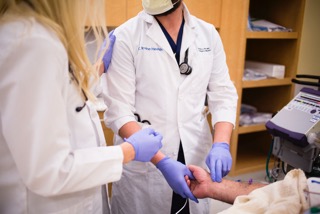Lectures
Approach to the Poisoned Patient
DOI: https://doi.org/10.21980/J8264SBy the end of the lecture, learners should be able to: 1) initiate the evaluation of a poisoned patient, 2) identify key interventions to support airway, breathing, and circulation, 3) identify the three components of risk assessment in the poisoned patient, 4) list the four options for gastric decontamination, and 5) select standard diagnostic labs and tests commonly used in evaluating poisoned patients.
A Just-in-Time Video Primer on Pneumothorax Pathophysiology and Early Management
DOI: https://doi.org/10.21980/J8891JBy the end of this module, participants should be able to: 1) review the normal physiology of the pleural space; 2) discuss the pathophysiology of pneumothorax; 3) describe the clinical presentation of pneumothorax; 4) identify pneumothorax on a chest radiograph; and 5) review treatment options for pneumothorax.
Hosting an eConference: Interactive video conference grand rounds between two institutions
DOI: https://doi.org/10.21980/J88P80Our objectives were to create and implement a novel virtual conference format through the integration of social media tools which allows for interdisciplinary and multi-site participation to enhance EM resident education. We wish to outline the steps required to reproduce this innovative session and share lessons learned.
A Brief Didactic Intervention to Improve Multiple-Choice Item-Writing Quality
DOI: https://doi.org/10.21980/J81633The primary objective of this training module is to provide emergency medicine residents and faculty the basic knowledge necessary to write high quality structured single-best answer examination items through a brief, independent study format.
ED I-PASS: A Streamlined Version of the I-PASS Patient Handoff Tool for the Emergency Department
DOI: https://doi.org/10.21980/J80G8FThe purpose of this presentation is to provide ED providers with a tool that may improve the safety of their patient handoffs. By the end of this presentation, the learner will be able to 1) describe the importance of safe and efficient handoffs, 2) recall each element of the I-PASS mnemonic, and 3) demonstrate an understanding of how it can be feasibly performed in a busy ED setting.
A Faculty Development Session or Resident as Teacher Session for Didactic and Clinical Teaching Techniques; Part 1 of 2: Engaging Learners with Effective Didactic Teaching
DOI: https://doi.org/10.21980/J8RP4TBy the end of this workshop, the learner will: 1) describe eight teaching techniques that encourage active learning during didactic sessions; 2) plan a didactic session using at least one of eight new teaching techniques for didactic instruction
A Faculty Development Session or Resident as Teacher Session for Clinical and Clinical Teaching Techniques; Part 2 of 2: Engaging Learners with Effective Clinical Teaching
DOI: https://doi.org/10.21980/J8MW2WBy the end of this workshop, the learner will: 1) describe and implement nine new clinical teaching techniques; 2) implement clinical teaching techniques specific to junior and senior resident learners.
‹2
Page 2 of 2


